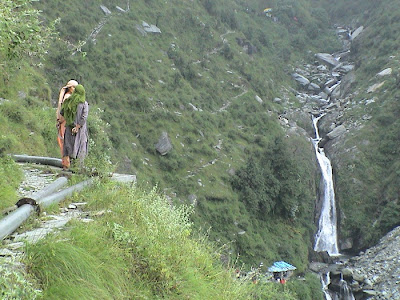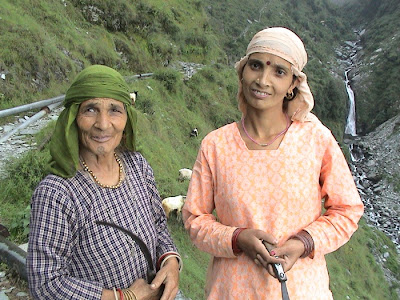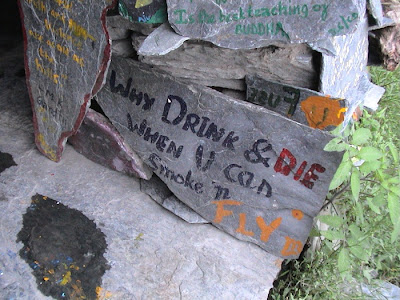Hidden Treasures: The Waterfall near Dharamsala
Emerging out of the fumes and flesh of a city like Delhi can be refreshing no matter which direction one heads. But it is particularly nice when one takes a bus 9 hours to the north, to Dharamsala.

The two shepherdesses and the waterfall
Located in the foothills of the Himalayas, Dharamasala is best known as the home of the Tibetan government in exile, headed by the Dalai Lama. Tourists, Tibetans, and Indians stroll its alleys and streets. Monkeys roughhouse in the garbage dump on the edge of town, or nap in trees at the Dalai Lama’s residence. Young backpackers, when not preoccupied by drugs, are hiking the hills, lounging in one of the town’s rustic but cozy cinemas, or perhaps dabbling in meditation.
There was much I loved about Dharamsala during my week’s stay. The air was fresh and smelled good—a stark difference from Delhi. The ruddy faces of Tibetans, ubiquitous here, left me in a pleasant geographical version of a time warp—having been to Tibet earlier in the year I now had difficulty remembering I was in India. The food was good, the temperature mild, and the eclectic mix of people fascinating.

Dharamsala, India
And then there was the waterfall, located about an hour’s walk from the center of town. By no means was it the “highlight” of Dharmasala — many visitors spend a week in town without ever making it to the waterfall. But it holds a soft spot in my own memory because it was one of the first places I walked upon arrival.
I remember the pleasant crunch of gravel as I walked along a dirt road to get to the trailhead. It was a sound absent in Delhi, which was all pavement and concrete. Here my eyes took in evergreen trees and mountain vistas, my skin felt the drifting mist, and my nose — ah, my nose — felt as lively as a bloodhound's snout, nearly prodding me to let loose a howl at the scent of forest, wet soil, and pure air (or at least air that didn’t come directly from an exhaust pipe).
Once on the trail itself, I passed two Indian women, standing on the hillside as their goats, which they had brought up here to feed, ripped up grass around them. This too—the ripping and gnawing — was a pleasant sound. And their obvious friendship — they had come to shepherd their goats together, and were in the midst of conversation when I appeared — was a pleasing sight.

The women and their goats (background)
Soon I was at the waterfall itself, where a local ran a very simple coffee shop by the water’s edge. He also had stones which people could paint a message on (for a few rupees). I was content to merely read some of what others had written:
“Don’t Try and Understand Everything”
“You Must Be the Change you Wish to See in the World”
“Everybody had to go to Paradise because Hell is Full”
“Jorrow is what man needs: neither joy nor sorrow, disattachments”
“If you are American, choose peace not war. No Bush in Nov 2004” [I was visiting in Sep 2004]

One of the more frivolous messages left on stone
The messages were sometimes cliché, sometimes humorous, sometimes actually rather provocative and meaty. It was while reading them that I met Dirk, a German traveler with whom I would later eat dinner and remain in touch with even till now.
Together we walked back to Dharamsala. It was a community made up of people far from home — sometimes happily so.
Joel Carillet, rhe first chief editor of Wandering Educators, is a freelance writer and photographer based in Tennessee. He is the author of 30 Reasons to Travel: Photographs and Reflections from Southeast Asia. To learn more about him, visit www.joelcarillet.com.
-

- Log in to post comments




















